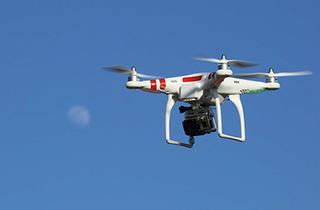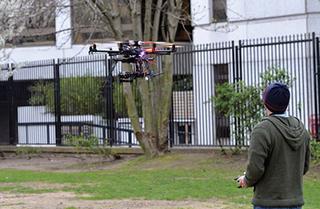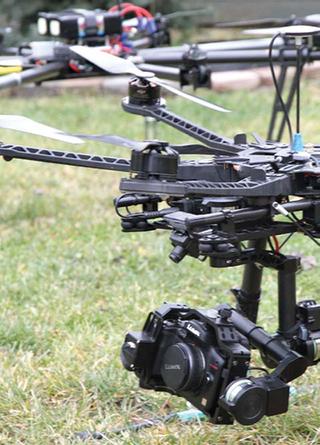Choppers v. Drones for ENG

OTTAWA, ONTARIO—The double-fatality crash of the KOMO-TV news helicopter in Seattle in March is just the latest in a series of deadly news helicopter crashes in recent years. At least 18 people have died in U.S. news copter crashes since 2000, with another 19 injured, according to data compiled by New York Magazine.
At the same time, it costs anywhere from $600,000 to $1 million a year to maintain, fuel, man (two pilots) and fly a chopper on an as-needed basis, at a time when TV stations are cutting news staff to save money.
“In contrast, a news drone can cost as little as $3,500,” said Ian Hannah, owner and operator of Avrobotics, a Toronto-based aerial footage company that flies video drones within stringent Canadian aviation regulations.
Given these high human and financial costs, the possibility of using economical camera-equipped “news drones”—remotely-controlled fixed-wing and rotary-wing aircraft—is once again being promoted by broadcasters and their advocates. One of them is Mike Cavender, executive director of the Radio Television Digital News Association.

Unlike in the U.S., media enterprises in other countries are allowed to use drones for news coverage. In this picture, a drone captures aerial views as it flies over London’s South Bank and lands outside ITV studios last month. It was being used to film aerial views of ITV for new look GMTV. “I think there’s no question that we need to see the whole concept of ‘news drones’ fast-tracked,” he said. “When I was running a TV station we lost a helicopter; thankfully there was no loss of life. So it’s just a shame that we don’t have the right to use a new technology like drones to supplement or even replace news helicopters; but right now we don’t.”
FAA IN THE WAY
The reason is the U.S. Federal Aviation Administration, which defines news drones as “unmanned aircraft systems.” “A news organization’s use of a UAS is ‘commercial,’” said an FAA spokesperson. “A commercial flight requires a certified aircraft, a licensed pilot and operating approval. To date, one operation met these criteria, using Insitu’s ScanEagle, and authorization was limited to the Arctic.”
For a few hours on March 6, 2014, it was legal to fly news drones in the U.S. That was after Patrick Geraghty, a judge on the U.S. National Transportation Safety Board, threw out a $10,000 FAA fine imposed on drone videographer Raphael Pirker, who had used a drone to shoot promotional aerial footage at the University of Virginia in Charlottesville, Va.
Get the TV Tech Newsletter
The professional video industry's #1 source for news, trends and product and tech information. Sign up below.
“The NTSB judge found that the FAA did not have actual regulations in place to govern UASes; just guidelines that weren’t enforceable,” said Professor Matt Waite, who runs the “Drone Journalism Lab” at the University of Nebraska-Lincoln’s College of Journalism and Mass Communications. “He also took issue with the FAA’s definition of aircraft, noting that their approach gave them jurisdiction over toy balsa wood gliders.”
Unfortunately for Pirker and other “commercial” UAS operators, the FAA appealed Judge Geraghty’s decision to the full NTSB board. This effectively stayed the decision, leaving the call in the FAA’s court. The administration— which has a September 2015 Congressionally-mandated deadline to draft UAV rules—has scheduled its first public meeting on UAS rules, May 28 in Washington, D.C.
In contrast to the United States, it is legal for news organizations to use drones in Canada. However, those drones have to be flown by licensed pilots certified by Transport Canada, the country’s aviation regulator, and handled in compliance with Special Operations Flight Certificates.
“Typically, you have to file for a SOFC at least 20 days before each flight,” Hannah said. “Because we have built up a proven track record in doing safe UAS flights within the rules, Transport Canada has given us a one-year blanket SOFC. This means that we can do news shoots, within limits.”
Those limits include not flying in downtown areas, not flying over people, and flying no higher than 400 feet. “If something happened in downtown Toronto, we couldn’t cover it,” Hannah said. “But if it happened in an open area, without people underneath, we could.”
Ironically, although Hannah is currently discussing providing services to Canada’s TV news organizations, “We have yet to do any work for them,” he said.
‘GUERRILLA DRONES’
While the FAA develops rules for commercial drone usage—it’s not clear if these rules will allow their use or simply enforce the current ban—“guerilla drones” are already being deployed by unauthorized videographers.
A case in point: After the March 12, 2014, natural gas blast that levelled two East Harlem apartment buildings, self-defined “citizen journalist”/drone pilot Brian Wilson arrived on the scene with a small camera-equipped quadcopter, “and flew very close to the scene and first responders in a reckless and dangerous manner,” said Matthew Schroyer, a reporter who runs the Professional Society of Drone Journalists.

The increased use of DSLRs to shoot video has enhanced interest in drones among media companies. Wilson sold his footage, which got him in trouble with the FAA. Schroyer also wasn’t impressed. “Had he lost radio contact with the drone—and that can happen in a downtown core with lots of radio interference—it could have crashed and injured or killed someone,” Schroyer said.
Brian Wilson isn’t alone in shooting news footage using drones; lots of people are. There’s so many doing it, that CNN’s citizen-supported iReport news site is now openly soliciting drone videos.
“Have you ever used an unmanned aerial vehicle to shoot photos or video?” asks a CNN posting. “Share your work here and tell us how you did it. We’ll feature the best on CNN.com/Tech.” At press time, the site had 57 drone-shot videos, including footage of a sandstorm over urban Phoenix.
CLOUDY FUTURE
By not paying for these videos, CNN is technically avoiding the FAA’s wrath. But there’s no doubt that these are news videos being exploited for profit by a commercial news organization, despite the fact that they have been shot using amateur-operated drones.
Meanwhile, the FAA’s resistance to “commercial drones” appears to be only constraining news professionals who are willing to follow rules. “We are open to following common sense conditions, including a requirement for trained drone pilots obeying the law,” said Mickey Osterreicher, general counsel for the National Press Photographers Association. “We just want to have input into how the FAA defines these rules, to ensure that they are common sense and fair.”
Time will tell if the FAA catches up to the new reality of drones, and creates a reasonable format for their legal use. As for the illegal use, It’s already underway, and flourishing.
James Careless is an award-winning journalist who has written for TV Technology since the 1990s. He has covered HDTV from the days of the six competing HDTV formats that led to the 1993 Grand Alliance, and onwards through ATSC 3.0 and OTT. He also writes for Radio World, along with other publications in aerospace, defense, public safety, streaming media, plus the amusement park industry for something different.

